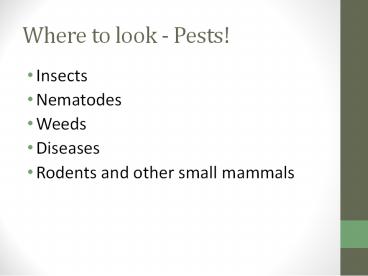Where to look - Pests! - PowerPoint PPT Presentation
1 / 15
Title:
Where to look - Pests!
Description:
Where to look - Pests! Insects Nematodes Weeds Diseases Rodents and other small mammals Basic classification Kingdom Phylum Class Order Family Genus Species Kings ... – PowerPoint PPT presentation
Number of Views:87
Avg rating:3.0/5.0
Title: Where to look - Pests!
1
Where to look - Pests!
- Insects
- Nematodes
- Weeds
- Diseases
- Rodents and other small mammals
2
Basic classification
- Kingdom
- Phylum
- Class
- Order
- Family
- Genus
- Species
- Kings Play Chess On Fine Green Silk
3
Starting at the beginning
- 4 types of Phyla
- Arthropoda ( insects, spiders, mites, millipedes)
- Aschelminthes (roundworms)
- Platyhelminthes (Flatworms, flukes, tapeworms)
- Mollusca (snails, slugs, clams)
- Arthropoda Phyla is divided into classes
- Crustacea (Crayfish, sowbugs)
- Arachnida (spiders, ticks, mites)
- Insecta ( bugs, beetles, butterflies)
4
Classification cont.
- Insecta Class is divided into Orders
- Orthoptera (grasshoppers)
- Homoptera (aphids)
- Coleoptera (beetles)
- Lepidoptera (moths, butterflies)
- Diptera (flies)
- Dermoptera (earwigs)
- Hemiptera (true bugs)
- Hymenoptera (ants, bees)
5
Rules to fall into Classes and Orders
- Arachnida
- must have 2 body segments or parts
- must have 4 pairs of legs
- some mites are major plant pests
- Insects
- all have three body regions head, thorax,
abdomen - 3 pairs of legs
- 1 pair of antennae
- 0 to 2 pairs of wings
6
Head Body Parts
- Antennae segmented, vary in form.
- Primarily the smell organ
- Mouthparts
- rasping-sucking
- chewing-lapping
- piercing-sucking
- sponging
- siphoning
- chewing
7
Body Parts
- Thorax made of 3 sections, each containing a
pair of legs - legs are jointed
- used for digging, feeling, swimming, and cleaning
- Wings - differ for each insect
- serve as an identification tool
- -ptera means with wings
8
Metamorphosis
- Development of the body after birth
- Gradual (or incomplete) - insects life cycle
changes from egg through the nymph to adult - nymph, similar to adult except for size and color
- aphids, leafhoppers, mole crickets
- Complete - 4 life stages
- egg, larvae, pupae, adult
- larvae looks nothing like adult
- pupae is a transformation stage
- caterpillars-moths, grubs-beetles, maggots-flies
9
Beneficial Insects
- Not all insects are bad for agriculture
- They help
- pollinate plants
- improve soil
- destroy harmful insects
10
Other types of pests
- Nematodes
- Weeds
Southern root-knot nematodes on pepper plant
roots.
This weed is leafy spurge.
11
Other types of pests
- Diseases
- Rodents and other animals
12
What is Entomology
- The branch of zoology that deals with the study
of insects
13
Human Interaction
- There are only approximately 10,000 species of
insects that are harmful to humans - Deadly epidemics of the past have been caused by
diseased organisms carried by insects - Example
- Bubonic Plague epidemic that wiped out the
population of Europe in the 14th century was
carried by fleas that infested rodents
14
DDT (Dichlorodiphenyltrichloroethane)
- A chemical that was discovered by a German
scientist named Othmar Zeidler in 1874 - Used to reduce the number of insects in a given
area - Example
- Mosquitoes in the tropics
- Eventually banned due to the side affects to
wildlife animals and plants - Silent Spring
15
Integrated Pest Management (IPM)
- Cultural methods
- Vary country to country
- Insect diseases and predators
- Pheromones
- Release of sterile males
- Insect resistant plant varieties































